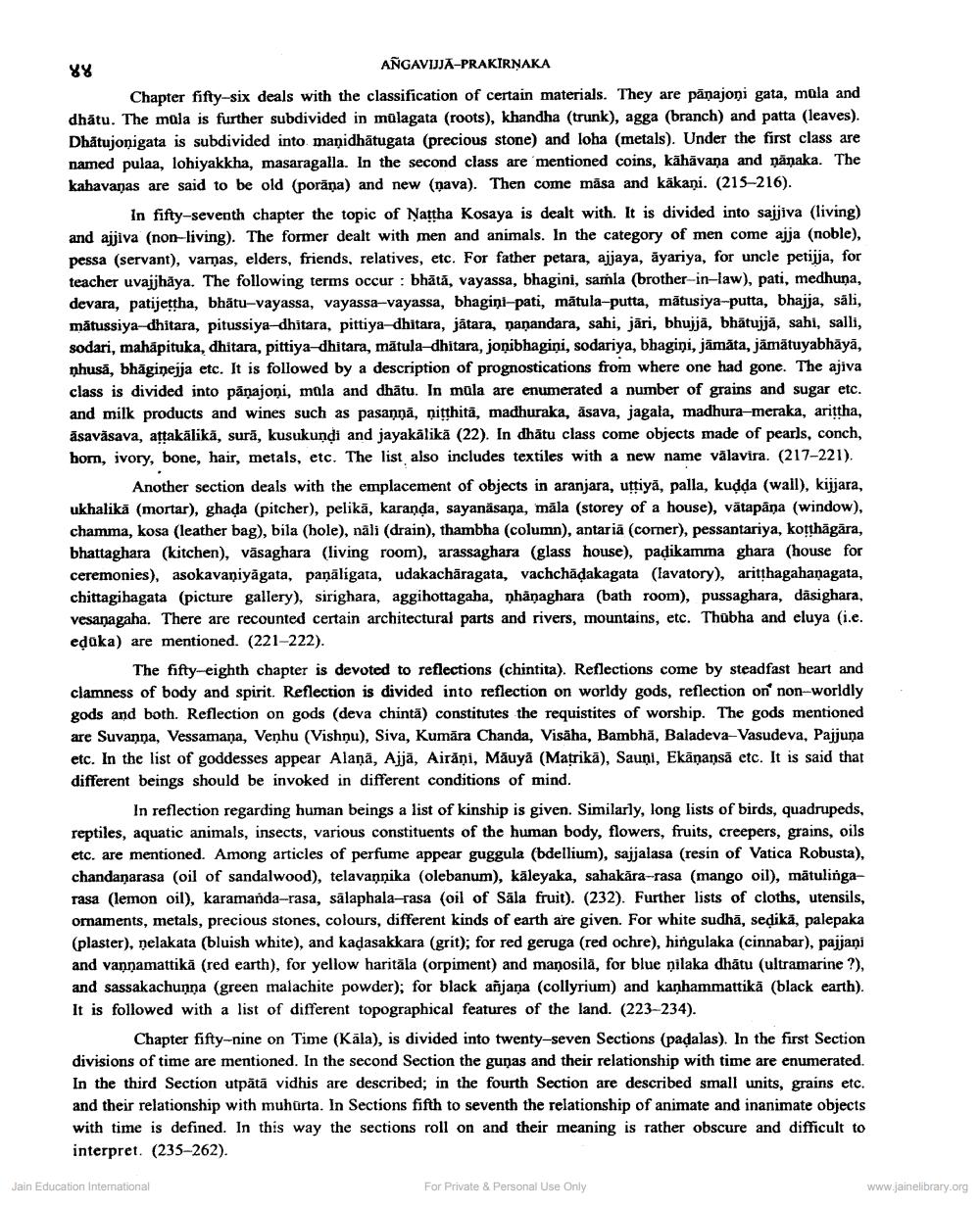________________
४४
ANGAVIJJA-PRAKIRŅAKA Chapter fifty-six deals with the classification of certain materials. They are panajoni gata, mola and dhātu. The mala is further subdivided in mulagata (roots), khandha (trunk), agga (branch) and patta (leaves). Dhấtujonigata is subdivided into manidhätugata (precious stone) and loha (metals). Under the first class are named pulaa, lohiyakkha, masaragalla. In the second class are mentioned coins, kähāvana and nänaka. The kahavanas are said to be old (porāna) and new (nava). Then come mäsa and käkani. (215-216).
in fifty-seventh chapter the topic of Nattha Kosaya is dealt with. It is divided into sajjiva (living) and ajjiva (non-living). The former dealt with men and animals. In the category of men come ajja (noble), pessa (servant), varnas, elders, friends, relatives, etc. For father petara, ajjaya, āyariya, for uncle petijja, for teacher uvajjhāya. The following terms occur : bhātā, vayassa, bhagini, samla (brother-in-law), pati, medhuna, devara, patijettha, bhätu-vayassa, vayassa-vayassa, bhagiņi-pati, mätula-putta, mātusiya-putta, bhajja, säli, mātussiya-dhitara, pitussiya-dhitara, pittiya-dhitara, jātara, nanandara, sahi, jāri, bhujjā, bhätujja, sahi, salli, sodari, mahapituka, dhitara, pittiya-dhitara, mātula-dhitara, jonibhagini, sodariya, bhagini, jämăta, jämätuyabhāyā, nhusā, bhāginejja etc. It is followed by a description of prognostications from where one had gone. The ajiva class is divided into panajoni, mala and dhätu. In mula are enumerated a number of grains and sugar etc. and milk products and wines such as pasanna, nitthita, madhuraka, asava, jagala, madhura-meraka, arittha, āsavāsava, attakälikä, surā, kusukundi and jayakālikā (22). In dhätu class come objects made of pearls, conch, bor, ivory, bone, hair, metals, etc. The list also includes textiles with a new name välavira. (217-221),
Another section deals with the emplacement of objects in aranjara, uttiyā, palla, kudda (wall), kijjara, ukhalikā (mortar), ghada (pitcher), pelikā, karanda, sayanåsaņa, māla (storey of a house), vätapāņa (window), chamma, kosa (leather bag), bila (hole), näli (drain), thambha (column), antaria (corner), pessantariya, kotthāgāra, bhattaghara (kitchen), väsaghara (living room), arassaghara (glass house), padikamma ghara (house for ceremonies), asokavaniyāgata, paņāligata, udakachäragata, vachchädakagata (lavatory), aritthagahanagata, chittagihagata (picture gallery), sirighara, aggihottagaha, nhãņaghara (bath room), pussaghara, dasighara, vesanagaha. There are recounted certain architectural parts and rivers, mountains, etc. Thubha and eluya (i.e. eduka) are mentioned. (221-222).
The fifty-eighth chapter is devoted to reflections (chintita). Reflections come by steadfast heart and clamness of body and spirit. Reflection is divided into reflection on worldy gods, reflection on non-worldly gods and both. Reflection on gods (deva chintä) constitutes the requistites of worship. The gods mentioned are Suvanna, Vessamana, Venhu (Vishnu), Siva, Kumāra Chanda, Visäha, Bambha, Baladeva-Vasudeva, Pajjuna etc. In the list of goddesses appear Alaņā, Ajjā, Airāņi, Māuyā (Matrikā), Sauņi, Ekāņaņsă etc. It is said that different beings should be invoked in different conditions of mind.
In reflection regarding human beings a list of kinship is given. Similarly, long lists of birds, quadrupeds, reptiles, aquatic animals, insects, various constituents of the human body, flowers, fruits, creepers, grains, oils etc. are mentioned. Among articles of perfume appear guggula (bdellium), sajjalasa (resin of Vatica Robusta), chandanarasa (oil of sandalwood), telavaņņika (olebanum), kāleyaka, sahakāra-rasa (mango oil), mātulinga rasa (lemon oil), karamanda-rasa, sālaphala-rasa (oil of Sāla fruit). (232). Further lists of cloths, utensils, ornaments, metals, precious stones, colours, different kinds of earth are given. For white sudhā, sedikā, palepaka (plaster), nelakata (bluish white), and kadasakkara (grit); for red geruga (red ochre), hingulaka (cinnabar), pajjani and vannamattikā (red earth), for yellow haritāla (orpiment) and manosila, for blue milaka dhatu (ultramarine ?), and sassakachunna (green malachite powder); for black añjana (collyrium) and kanhammattikā (black earth). It is followed with a list of different topographical features of the land. (223-234).
Chapter fifty-nine on Time (Kāla), is divided into twenty-seven Sections (padalas). In the first Section divisions of time are mentioned. In the second Section the gunas and their relationship with time are enumerated. In the third Section utpātā vidhis are described; in the fourth Section are described small units, grains etc. and their relationship with muhurta. In Sections fifth to seventh the relationship of animate and inanimate objects with time is defined. In this way the sections roll on and their meaning is rather obscure and difficult to interpret. (235-262).
Jain Education International
For Private & Personal Use Only
www.jainelibrary.org




